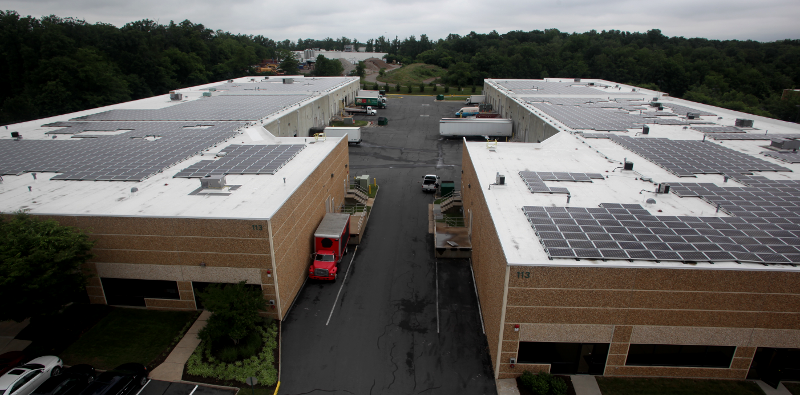
3,000 solar cells were installed on the roof of the Prologis Concorde Distribution Center in Sterling in 2015
Source: Dominion Media Downloads, Prologis Rooftop Solar Installation

3,000 solar cells were installed on the roof of the Prologis Concorde Distribution Center in Sterling in 2015
Source: Dominion Media Downloads, Prologis Rooftop Solar Installation
Some early home-based solar projects in Virginia used black tubes filled with water on rooftops to create hot water. The water, pre-heated by the sun, was piped into water heaters. With pre-heated water, less energy was required to provide hot water for sinks, showers, and washing machines.
The hot water systems required additional plumbing and sometimes costs for reinforcing roofs to support the additional weight, and were plagued by wintertime freezing unless systems were drained and decommissioned seasonally.
In Virginia, almost all plans for solar energy rely now upon photovoltaic cells. The theoretical physical foundation for generating electricity from sunlight, the photoelectric effect, finally earned Albert Einstein a Nobel Prize in 1922. Solar panels became a cost-effective option after Germany committed to renewable energy in the 1990's. The generous subsidies for Germans to install solar panels triggered a manufacturing boom in China. That country became the dominant supplier. Economies of scale and manufacturing efficiencies enabled Chinese producers to reduce the price by 85% between 2010-2020, earning China 70% of solar cells by then.1
Another solar power option, unlikely to be used in Virginia, is to build a circle of mirrors on the ground that are tilted at different angles throughout the day to concentrate sunlight at a central tower, creating steam that drives a turbine to generate electricity. Virginia is located north of the 36° parallel of latitude and cloud cover is common, so the amount of direct sunlight does not justify the costs of building heliostat systems with "power towers."
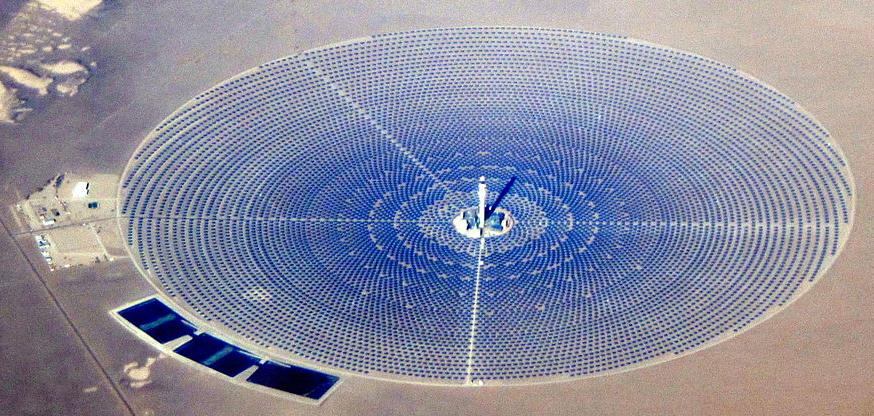
Virginia (unlike Nevada) lacks the clear skies that would justify construction of heliostat systems, with mirrors concentrating sunlight on a central tower to generate steam
Source: Wikipedia, Crescent Dunes Solar Energy Project
Photovoltaic projects in Virginia include small (typically 2-4 kilowatt) rooftop systems on individual homes. Utility-scale projects are measured in megawatts (MW) rather than kilowatts (KW), such as Amazon's 80MW facility at Oak Hall in Accomack County.
Individual homeowners can use solar panels to create enough electricity to meet their requirements. The scale of each project is small, but Virginia has over three million housing units. Rooftop solar has the potential for meeting a significant amount of the demand for electricity in Virginia, but that potential may not offset plans by the state's two investor-owned utilities for constructing new power plants fueled by natural gas.
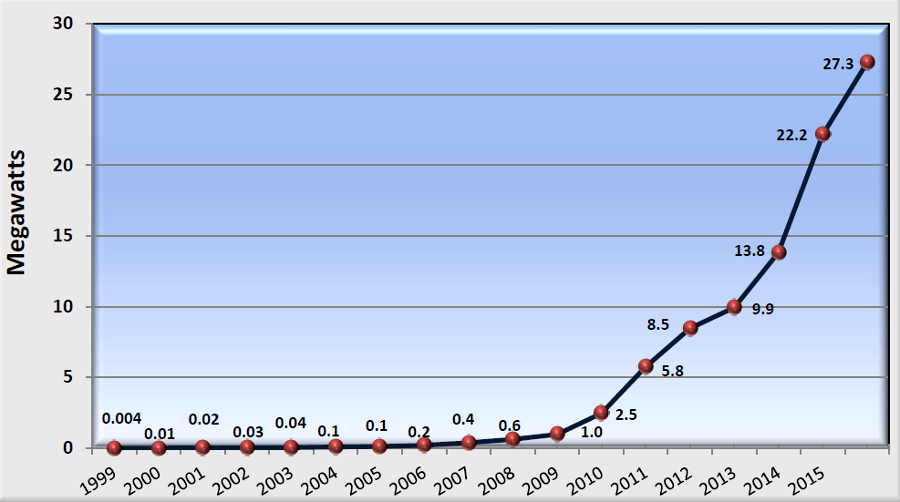
until 2010, there was little net metered solar generation in Virginia
Source: Virginia Solar Energy Development Authority, 2016 Annual Report (p.1)
Peak demand shapes the planning of those utilities for adding new capacity. Each solar panel offsets just a tiny amount of demand, and the number of panels installed each year is not yet sufficient to eliminate the need for new power plant construction.
One reason for the slow addition of solar panels to existing houses is that retrofits are expensive. Though the electricity generated by panels is free, homeowners still must pay a monthly fee to their utility to be connected to the grid and have power 24/7. Commercial customers also pay a demand charge, based on their peak use of electricity each month, so people who install solar panels to get "free" electricity still pay a fee each month to their utility company. To be cost effective, a retrofit must offset enough electrical use to pay for the costs of buying and installing panels despite the monthly fees.

solar advocates suggest that the solution to the energy challenge comes up every morning, but costs to install solar panels can exceed benefits
Source: Assateague Island National Seashore, Sunrise
As a result of the cost-effectiveness challenges, solarizing individual homes is a niche business in Virginia. The State Corporation Commission (SCC) in Virginia and utilities consider projections for increased demand before investing in construction of a traditional electricity generating facility fueled by coal, natural gas, or nuclear sources, but the fragmented investments in household solar projects are not aggregated enough to offset proposals for building a particular power plant.
State law and regulations grant different utilities a monopoly to provide electricity within defined service areas, and that limits the potential for building community solar projects that might combine enough solar panels to alter plans for constructing new power plants. Half the residential units and businesses in the United States are unable to install solar panels due to roof orientation, insufficient space, or shade from trees.
Utilities have blocked efforts in Virginia to establish community solar projects, where property owners with south-facing roofs could install oversized systems and share electricity with their neighbors whose roofs might face north or be too deep in the woods.
"Solarize" groups in various Virginia communities, such as Solarize Blacksburg and Solarize Harrisonburg, have consolidated projects by individual homeowners with one contractor. Consolidation created an economy of scale, reducing costs for purchasing photovoltaic panels in bulk and simplifying the contractor's planning to install them on multiple rooftops. To comply with state law and regulations, each customer is allowed to install enough photovoltaic panels to generate electricity to meet their own demand, but may not install extra panels and sell electricity to neighbors.
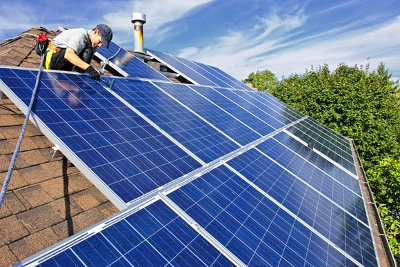
rooftop photovoltaic panels are manufactured outside of Virginia, but installation and maintenance create local jobs
Source: US Department of Energy, Photovoltaic Solar Cells
The first commercial-scale solar array in Virginia was installed in 2010 on the roof of the library at Eastern Mennonite University in Harrisonburg. The 328 panels had the capacity to generate 104 kilowatts (104kW).
The size of commercial solar projects has increased steadily since the initial start in 2010. By 2012, Washington and Lee was claiming it had the state's largest system with 1,500 panels capable of producing over 400kW.2
By 2014, Virginia's largest solar energy project was a 2.1 megawatt (2.1MW) system at the Norfolk Naval Station. It used 8,600 panels set up on 10 acres. The next largest project ws 6,000 solar panels on the old landfill next to the Veterans Administration hospital in Salem, which generated 1.6MW.3
In 2015, the largest rooftop solar array was a 3,000 solar panel system generating 759kw on the roof of the Prologis Concorde Distribution Center in Sterling. It surpassed the 2,000-panel, 0.5kW system completed at the Canon toner cartridge recycling plant in Gloucester, and a comparable system on top of the Ikea store in Woodbridge.
In 2016, Dominion Virginia Power completed a 3,000-panel system on Western High School in Chesapeake that was able to generate 1MW of electricity.4
Businesses seeking to be "green" for marketing purposes, or to hedge against a future rise in the cost of electricity, have hopped on the bandwagon. For example, Catoctin Distillery in Purcellville planned to meet 85% of its demand for electricity from 158 panels on its roof generating over 40kW.5
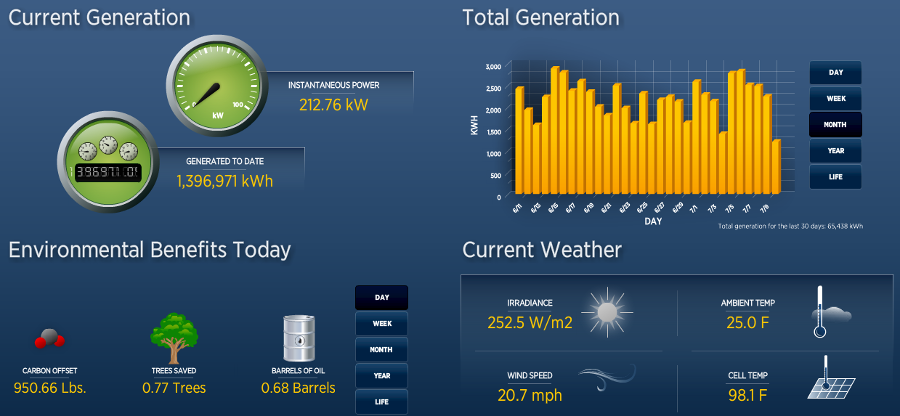
Washington and Lee University publicizes the operating status of its photovoltaic system
Source: Washington and Lee University, Overview (3:20pm on July 9, 2014)
Rooftop system will always be constrained by the square footage available on the roof, and by the capacity of buildings to support panels that weigh nearly 17 pounds apiece. Industrial-scale solar facilities with panels installed on the ground can be much larger, and their generating capacity could affect the traditional patterns of generating electricity.
In 2016, the National Renewable Energy Laboratory calculated that photovoltaic systems (PV) installed on rooftops could supply 39% of total national electric-sector sales. Virginia had 200 million square meters of available rooftop surface that could produce 20% of electric-sector sales within the state.
Nationwide, about two-thirds could come from small buildings (those with a footprint smaller than 5,000 ft2) such as individual houses, even though only 26% of the total rooftop area on small buildings was suitable for PV deployment. Within Virginia, small rooftops could provide 60% of the potential solar energy because:6
Dominion initially opposed solar power projects initiated by third parties such as Secure Futures in Staunton, which sought to take advantage of Federal tax credits by financing and installing photovoltaic systems for non-profits. Plans for solar power at Washington and Lee University were disrupted by Dominion's claims that it alone had the right to sell electricity to customers within its service areas, forbidding third party "power purchase agreements."
In 2013, Dominion chose to support projects to distribute solar-generated electricity through the grid, and the General Assembly authorized a pilot program to generate up to 50MW of new solar generating capacity under power purchase agreements.7
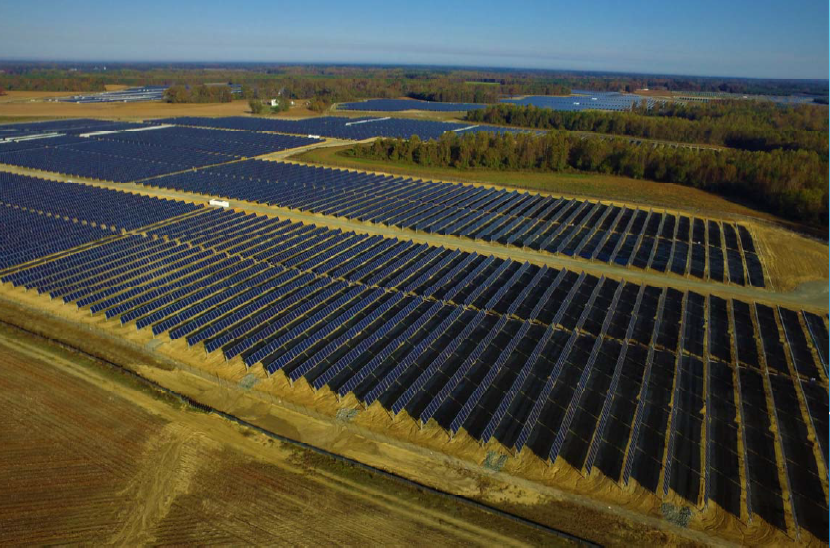
solar facility (farm) in Southampton County replaced farmland
Source: Rappahannock-Rapidan Regional Commission, Shedding a Light on Solar planning workshop, Southampton Solar (April 13, 2018)
Community Energy Solar, a private corporation with a track record of completing utility scale solar energy projects, obtained approval from Accomack County in 2015 for the Eastern Shore Solar Farms project. By building in Accomack County, the electricity could be sold to Delmarva Power - bypassing all the barriers created by Dominion to purchase of electricity from third-party providers, and also bypassing the local A&N Electric Cooperative.
Plans for the "largest solar energy facility on the East Coast" involved leasing 1,000 acres of land at Oak Hall near an existing electrical substation, and installing 250,000 solar panels to generate 80 megawatts (MW) of electricity. The leases were for a term of 30 years, an indication of the anticipated life expectancy before decommissioning the facility.
In June, 2015, Amazon Web Services announced that it was the customer for the electricity. Amazon planned to use renewable energy to power 100% of its facilities, including data centers in Northern Virginia and large distribution warehouses south of Richmond.
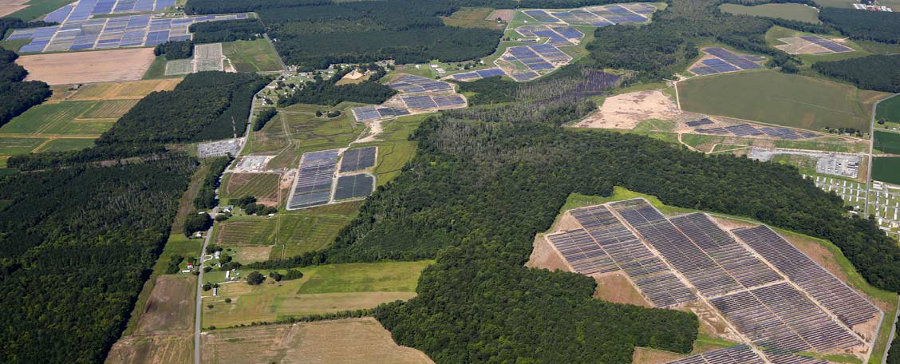
solar facility ("farm") built by Community Energy Solar in Accomack County
Source: Virginia Department of Mines, Minerals, and Energy, Energy in the New Virginia Economy: Update to the 2014 Virginia Energy Plan
Amazon had no such facilities on the Eastern Shore, but the electrical grid in the United States has wires connecting nearly every structure in the United States. Amazon could add 80 megawatts of solar-generated electricity to the grid in Accomack County and claim that renewable energy powered its Northern Virginia data centers and distribution warehouses.
In practice, generation on the Eastern Shore is added to the grid and alternating current flows back and forth there, close to Eastern Shore Solar Farms. No electrons actually flow from Accomack County to Amazon's data centers or warehouses on the other side of the Chesapeake Bay; current alternates rather than flows in a direct line, so the flow of electricity is not comparable to how water is pumped through a pipe. Thanks to the interconnected grid, however, generation on the Eastern Shore offsets the demand for generation closer to the data centers/warehouses.8
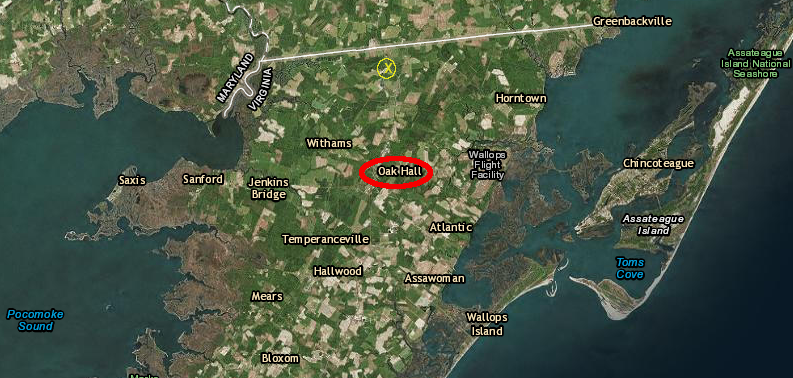
the solar facility built by Community Energy Solar in Accomack County was located near the oil-fired Commonwealth Chesapeake Power Station (yellow X), and Amazon is the sole customer buying that electricity
Source: ESRI, ArcGIS Online
Dominion, one of the two major utilities in Virginia, acquired the Accomack County facility in late 2015. Until that purchase, the largest solar project constructed by Dominion was installation of 8,000 solar panels on the ground in Chesterfield County. That project, on property owned by Phillip Morris, produced 2.5 megawatts of electricity.
After selling Eastern Shore Solar Farms, Community Energy Solar shifted its focus to Southampton County and proposed a 100MW solar project there in 2016. Amazon agreed to purchase that electricity, and Community Energy Solar sold that project to Dominion as well.
In 2016 a different solar developer, Virginia Solar LLC, announced its plans to develop four other 20MW facilities in New Kent, Buckingham, Sussex, and Powhatan counties and sell the electricity to Amazon. The Accomack County facility was the model; Dominion ended up owning solar farms developed by others, and Amazon agreed to purchase the renewable energy.9
The solar panels in the Southampton Solar project were placed in separate clumps spread over 1,200 acres of farmland. Since ground-based solar projects are not constrained by a building's footprint, they can create economies of scale and exceed the generating capacity of rooftop systems - but committing so much land to energy production vs. farming can be controversial. Dominion calculates that on average, 8,000 acres of cleared land are required for the solar panels that generate 1,000MW.10
Dominion has committed to building facilities to generate 400 MW of solar energy in Virginia by the year 2020. Most will be installed on property owned by Dominion, but 30MW of solar capacity will be generated by Dominion-owned solar arrays installed on the grounds/rooftops of commercial businesses and public properties. The companies and public agencies can advertise their commitment to solar power, while Dominion pays the construction costs and pays a small fee to lease space such as the rooftop at the Canon plant.11
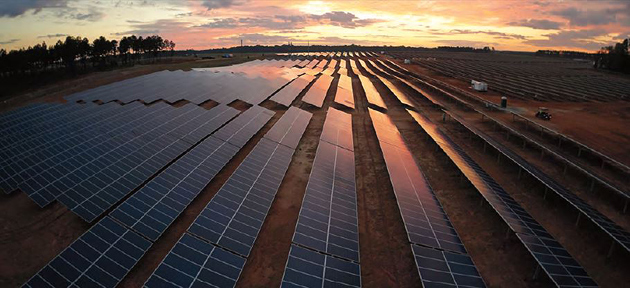
more cells can be installed at ground-based solar projects, so they typically generate more electricity than roof-based projects
Source: Dominion, Remington Solar Power Facility
Sunlight is free, but leasing land and constructing infrastructure involves an up-front cost just like building a coal-fired or nuclear power plant. The relative cost to generate electricity from commercial-scale solar arrays vs. plants fueled by natural gas is an issue for the state-regulated utilities in Virginia.
The costs to build and operate solar infrastructure are included in the rates authorized by the State Corporation Commission (SCC), the state agency that regulates electricity rates and investment in new facilities by investor-owned utilities. The SCC has sought to block at least one solar project, when the costs were viewed as excessive.
In 2015, Dominion announced plans for 20-megawatt solar array with 90,000 photovoltaic panels near Remington in Fauquier County. Choosing that location minimized the costs for connecting the commercial-scale facility to the grid. The Remington project was located next to Dominion's 608-megawatt gas-fired peaking plant, which is used when demand for electricity exceeds the supply from baseload plants.
The SCC denied approval for that Remington project. The SCC determined that it would be more cost-effective for the private utility to purchase electricity from other "third-party providers" through the PJM regional transmission organization. The final ruling noted:12
The project was revived in 2016. Governor McAuliffe committed the state to purchase the power, and the State Corporation Commission lacks the authority to regulate sale of electricity to the state. The state may have paid a higher-than-average rate, but Microsoft committed to purchase enough Renewable Energy Credits to offset the potentially-higher costs from the Remington site.13
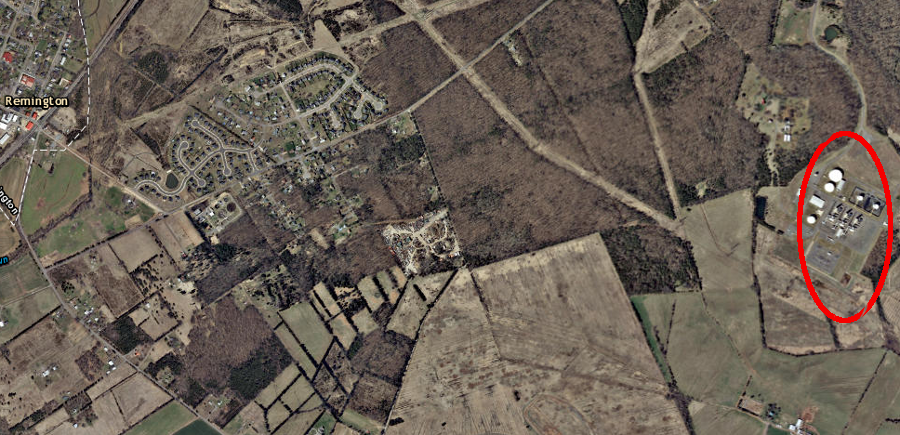
Remington was an attractive site for Dominion to build a 20MW solar farm, because the utility had access to sufficient land, the neighbors
had already accepted a gas-fired power plant - and it was next to a substation and transmission line to distribute the electricity to customers
Source: ESRI, ArcGIS Online
The Remington deal was part of a larger initiative. In 2015, the General Assembly passed several bills to spur development of solar-generated electricity. By creating the Virginia Solar Development Authority, the legislature hoped to link universities, utilities, and financiers to spur new projects. By declaring that 500MW of solar generation was "in the public interest," the legislature made clear to the SCC that cost should not be the only criterion for judging the suitability of a proposal.14
At the end of 2015, the state of Virginia committed to a Purchase Power Agreement with Dominion, guaranteeing that the state will buy all the electricity generated by 110MW of solar projects - an amount equivalent to all the electricity used by the community colleges.
Dominion planned to construct only 75% of the capacity, and to purchase the remaining 25% from third-party providers. That left open the opportunity for businesses to build rooftop systems and for competitors such as Community Energy Solar to construct large-scale solar arrays, then sell the electricity to Dominion for distribution.
The state committed to buy the solar-generated electricity at a price higher than the market rate set by the SCC in its tariffs. The deal ensured that if electricity generated from those solar projects ended up costing more than normal, taxpayers - rather than the Dominion's customers (ratepayers) or Dominion's stockholders - would subsidize the expansion of solar power in Virginia.
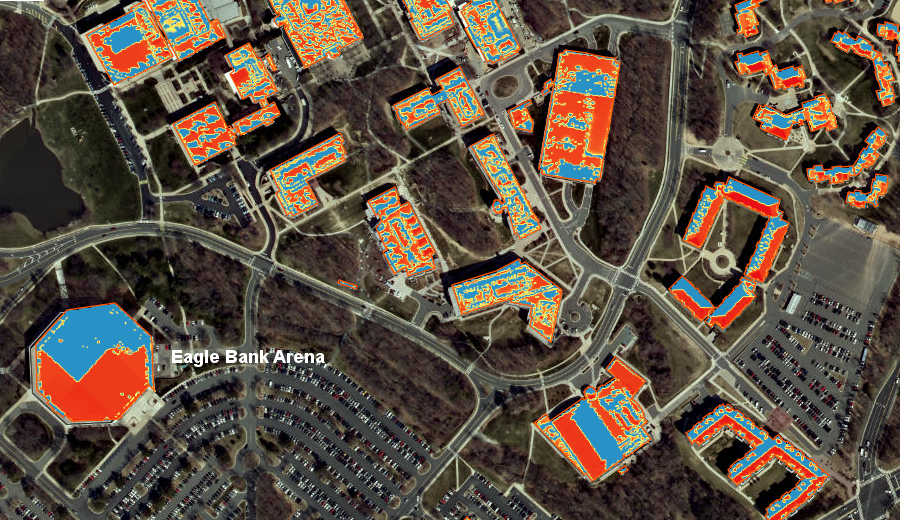
south-facing roofs have greater solar potential in the Northern Hemisphere, as shown by the Eagle Bank Arena at George Mason University's Fairfax campus
Source: Northern Virginia Regional Commission, Northern Virginia Solar Energy Map
In 2016, Dominion filed for approval of the 17.6MW Oceana Solar Facility at Naval Air Station Oceana. The $40 million project was designed as a public-private partnership between the utility and the Commonwealth of Virginia. Initial construction costs exceeded the equivalent costs to build a gas-fired generation plant, but the state committed to purchase the electricity for 25 years and to pay a negotiated cost that ensured Dominion would not lose money. The US Navy provided the land, anticipating the military facility would gain access to a micro-grid that would supply power even if there was an interruption in the delivery of electricity from the standard grid.
Each 1,000 kWh of solar-generated energy will create one renewable energy credit ("REC"). Homeowners and businesses purchase REC's to offset their use of electricity generated at a facility using fossil fuels such as coal and natural gas, a financial process that supports construction of renewable energy facilities at locations that may be located far from the customers willing to purchase certificates.
Utilities generating electricity at plants powered by fossil fuels purchase REC's to document their use of renewable energy, even if they have built no solar, wind, or biomass facilities. REC's demonstrate compliance with Renewable Portfolio Standards, but the solar power can be double-counted if the utility generating solar power claims to be "green" at the same time as the utility purchasing the REC's.
The Oceana Solar Facility will "earn" REC's. If sold to a utility, they could perpetuate operation of a coal-fired or gas-fired power plant, so the state and Dominion agreed not to generate additional income by selling the REC's from Oceana. Those certificates will be retired, rather than resold into the market.15
In 2016 the SCC authorized Dominion Power to build three solar projects that would generate up to 56MW of electricity and cost $130 million in total. To cover those costs, the SCC allowed Dominion a higher rate that would increase its bills to all customers. Spreading the higher costs across all of the utility's residential customers kept the increase to fund the solar projects to only $0.07/month.16
In response to public demand more than reflecting a need for increased generation, Dominion has a Solar Purchase Program for homeowners and businesses who want to install their own solar systems. Homeowners earn Renewable Energy Certificates for generating renewable energy, then sell the electricity and certificates to Dominion under a Purchase Power Agreement.
The homeowners/businesses finance and own their solar panels and wiring, up to the meters that measure use. The program requires using two meters at the site, one to measure consumption and one to measure generation, to determine the net amount of electricity added to the grid.
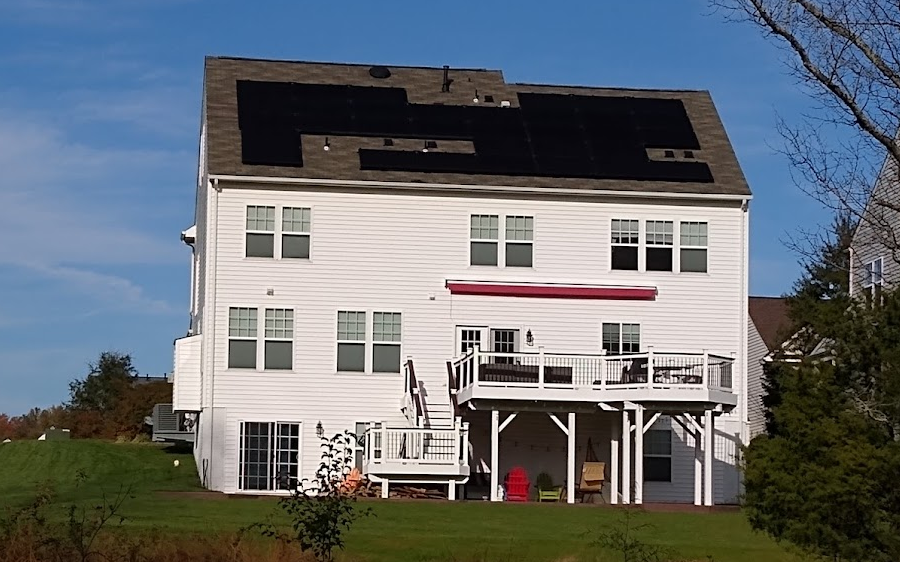
some Home Owner Associations (HOAs) prefer solar panels to be placed on the back side of roofs
Dominion will pay 15 cents per kilowatt-hour to such homeowners/businesses. That price is far above the cost of generating electricity at Dominion's coal-fired and nuclear power plants. Five-year contracts for purchase of the electricity offer an incentive to spur privately-funded installation of solar systems, but put Dominion at risk of having to purchase electricity at an excessively-high cost.
To limit the Solar Purchase Program's potential impact on the private corporation's bottom line, Dominion set a maximum cap at 3MW of solar power capacity. Individual customer capacity was limited to 20kW for residential customers and 50kW for non-residential customers, so the Solar Purchase Program gave the utility to highlight its willingness to "go solar" but limit the program to a small number of potential generators.
Most homeowners install 4-8kw solar systems. The 3MW cap meant that the Solar Purchase Program could accommodate only 600 customers with 5kw systems. To set priorities, Dominion created a first-come, first-served reservation system for interested customers.
Customers who plan to generate more electricity than they will use, and sell the excess to Dominion, use the Solar Purchase Program. Such customers get paid 15 cents per kilowatt-hour generated, and must pay only the SCC-approved rate for the kilowatt-hours used. Making a profit is theoretically possible, though the costs to install and maintain the solar cells must be factored into the business plan.
The utility has a separate Traditional Net Metering program for customers who want to install a smaller, less-expensive solar system designed just to offset their normal electricity use rather than to generate a surplus.
Homeowners/businesses who build their own solar system and generate electricity under the Traditional Net Metering program do not sell electricity to the utility. Instead, one bi-directional meter measures the two-way flow of electricity at a home or business. Agricultural operations, such as Windcrest Holsteins dairy farm in Timberville and the Riverbank Farm poultry operation in Dayton, have special authorization to use a subset of the program to consolidate billing at multiple meters.
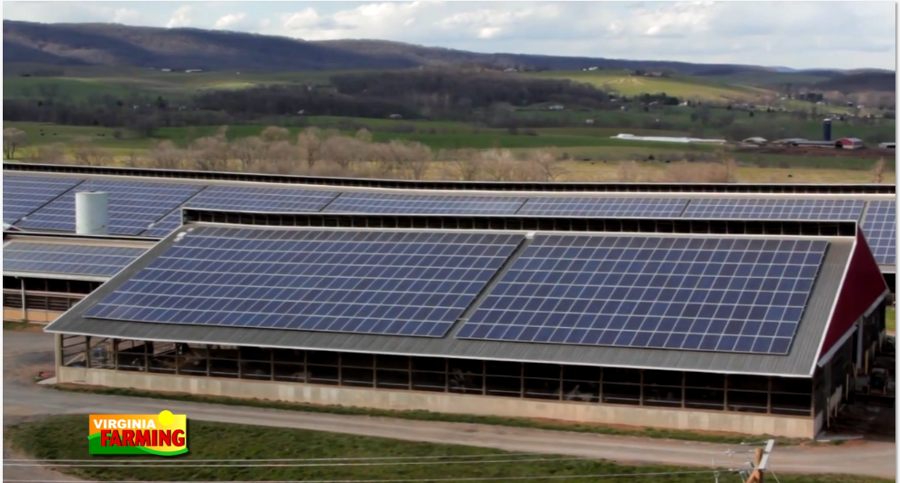
Windcrest Holsteins dairy farm in Timberville has installed 1,800 solar panels to create a 560kw system that meets 100% of its electricity needs, and electricity bills are offset through the Agricultural Net Metering program
Source: Virginia Farming, Solar Powered Farms
If the home/business generates more power during a billing period than is used, then the excess is credited for a later period (i.e., winter when there are fewer hours of sunlight). If the home/business produces more electricity than is used, Dominion gets the excess for free unless the customer has signed a power purchase agreement. Generators in the Traditional Net Metering program do retain their Renewable Energy Certificates, so excess production could still be compensated in part through sale of the certificates.
Dominion's electrical bills have multiple components. There is a fee for the amount of electricity used during the billing period, often divided into a fee for distribution (the costs of building/maintaining the local network of relatively low-voltage wires in the neighborhood) and a fee for actual electricity used. The fee for actual electricity used can be subdivided in charges for building/maintaining power plants (infrastructure for generating electricity), charges for building/maintaining the infrastructure of high-voltage wires for transmission from power plants to neighborhoods, charges for fuel, and charges for taxes.
Customers in the Traditional Net Metering program also must pay a monthly service charge for their link to the grid. That fee is not broken out separately for most homeowners. The fee is charged no matter how little electricity is used, even in months when a building with solar panels generates more electricity than is used. Though the net use might be zero, electricity still flows from the grid to the building at night.
If a customer wanted to generate their own electricity but avoid the standard service charge for use of the grid, they need to cut service from Dominion, go "off the grid," and rely upon a battery storage system to supply electricity at night. An alternative is to drop out of the net metering program and install batteries to store the excess electricity generated during the day, and rely on those backup batteries at night. Electricity usage drawn from the grid would be minimized, reducing the standard bill from the utility.17
There are other utilities in Virginia besides Dominion, and they have created their own programs. The City of Manassas, which purchases electricity wholesale and operates a municipal utility system that retails electricity to customers within the city, implemented a net metering program in 2015 after just a single customer requested it.
He installed a 4.3kw system that creates an excess beyond the needs of a single house in the summer. That house relies upon the city's grid to supply supplemental power in the winter when the solar cells are less productive.18
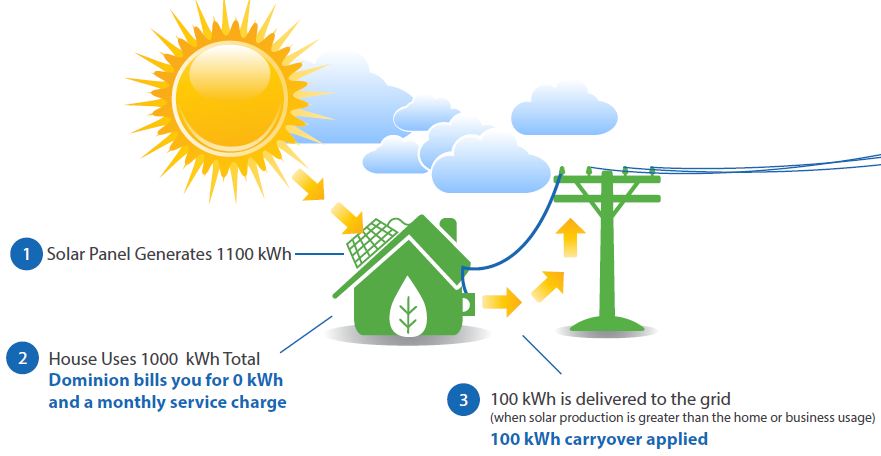
under the Traditional Net Meeting program offered by Dominion, homeowners can generate a surplus of electricity during summers with long, sunny days and offset costs for electricity used in the winter months
Source: Dominion, Net Metering
Homeowners installing large systems (more than 10 kilowatts) may generate more electricity than they use, and add more electricity to the grid than Dominion wants to manage. Dominion has established a "standby charge" to be paid each month by owners of residential solar systems larger than 10 kilowatts who are part of the Traditional Net Metering program, but no such fee is charged to Solar Purchase Program homeowners.
The standby charge is designed to cover the infrastructure costs of managing the decentralized input to the grid, separate from any purchase of electricity and in addition to the standard service charge billed to every customer. If demand exceeds 10kwh (kilowatt hours) for more than 30 minutes, Dominion will calculate the month's bill at a much higher rate.
Scott Sklar, a solar energy specialist in Northern Virginia, explained the billing to an unhappy homeowner:19
The state of Virginia, in contrast to some other states, does not have a mandatory Renewable Portfolio Standard (RPS) to force development of renewable energy sources.
Virginia established its first voluntary Renewable Portfolio Standard in 2007, and established goals for investor-owned utilities. The goal for 2025 is to generate from solar, wind, geothermal, hydropower, wave, tidal, and biomass sources an amount equivalent to 15% of all the electricity generated by that utility in 2007.
There is a key incentive to achieving the "voluntary" goal: the SCC can set rates that allow a utility to earn a higher profit if the utility is making adequate progress towards the voluntary goal.
In a reflection of the political influence of Dominion, perhaps more than in acknowledgement that nuclear power generates no greenhouse gases, the Renewable Portfolio Standard goal excluded the amount of electricity generated by nuclear-fueled power plants. Not counting nuclear substantially reduces the amount of electricity that Dominion must produce from renewable resources in order to qualify for the incentive.20
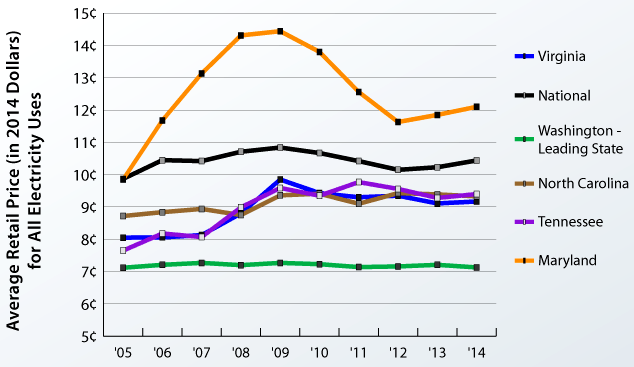
installation and maintenance costs for solar systems are not zero, and to be cost-effective a solar system must generate electricity cheaper than the retail price from the local utility
Source: Virginia Performs, Energy
Solar farms in rural areas do not add many jobs, but they increase land values and property taxes paid to local governments and require few local services. Electricity generating plants, unlike residential developments, do not increase the number of residents; therefore, solar farms do not increase local costs for schools, libraries, etc.
In 2016 the "Bluestone Farm" solar project was proposed in Mecklenburg County near Chase City, with 223,500 solar panels to be installed on 330 acres. A representative for the project noted:21
Nonetheless, local governments are not always in favor of solar projects.
In 2016, TurningPoint Energy obtained approval from the Pittsylvania County Planning Commission to place 1,300 solar panels on a 76-acre soybean farm. TurningPoint Energy planned to have a third-party investor finance and operate the solar farm for 25 years. The electricity would be sold to Danville Utilities, and its nearby substation was a key factor in site selection.
The site was also between an elementary school and high school. Planning commissioners were concerned about how the parcel would appear after the 25-year contract expired. The Planning Commission recognized the positive tax impacts of the project, but still voted to require TurningPoint Energy to get a bond guaranteeing the future removal of the panels and restoration of the site.
The solar array started feeding electricity to Danville Utilities in March, 2018. At that time, the 6MW system was Virginia's largest municipal utility solar facility.22
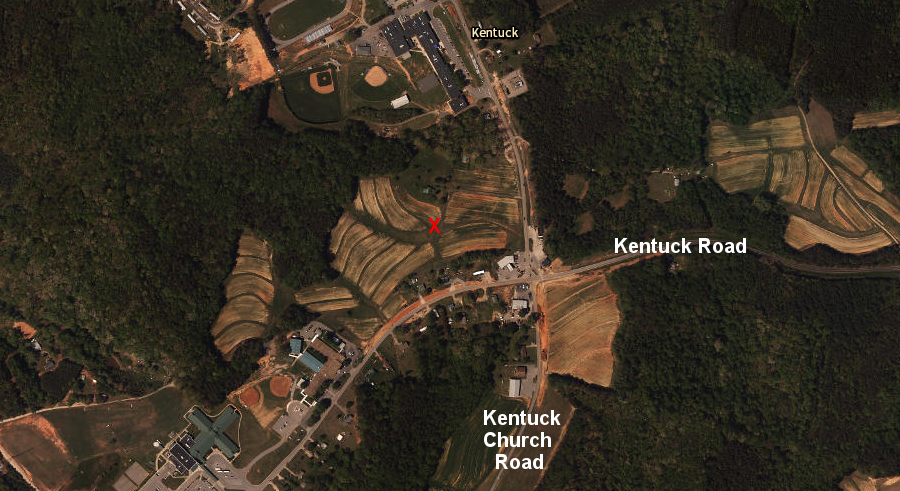
in 2016 the Pittsylvania County Planning Commission requires a proposed solar farm (red X) to obtain a bond that guaranteed 1,300 panels would ultimately be removed
Source: ESRI, ArcGIS Online
Also in 2016, SunEnergy1 and Dominion ran into opposition when they proposed to put 63,500 solar photovoltaic panels on 241 acres of farmland near the North Carolina border, far from any area zoned for industrial development.
That would take the Chesapeake farmland out of production, but local concerns also reflected fears that rezoning for a solar project could be followed by rezonings for residential/industrial development. One alternative proposed by opponents of the site on US 17 was to transfer the project to the site of Dominion's Chesapeake Energy Center. The coal-burning power plant there was closed in 2014, and the clay cap placed over the coal ash ponds could support the solar panels.
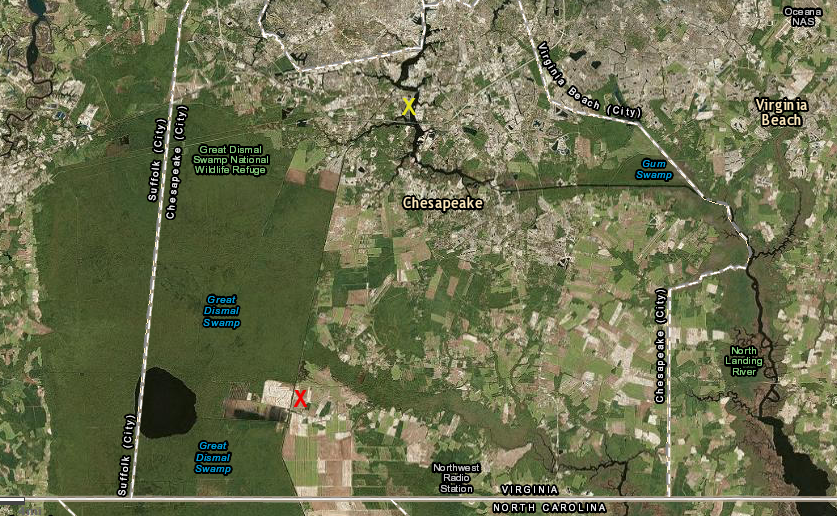
the 2016 proposal to put 63,500 solar photovoltaic panels on farmland (red X) was countered by suggestions to put the solar system at the former Chesapeake Energy Center (yellow X)
Source: ESRI, ArcGIS Online
A proposed 20MW solar project in Accomack County spurred local officials to choose agriculture over solar power in 2016. The rejected project would have converted farmland into an industrial solar facility, though Hog Island Sheep would be raised on the site. The 200-acre farm near the Tasley power substation had been a candidate for the Eastern Shore Solar Farms project that Dominion Power eventually bought, after Amazon Web Services agreed to purchase all the renewable energy.
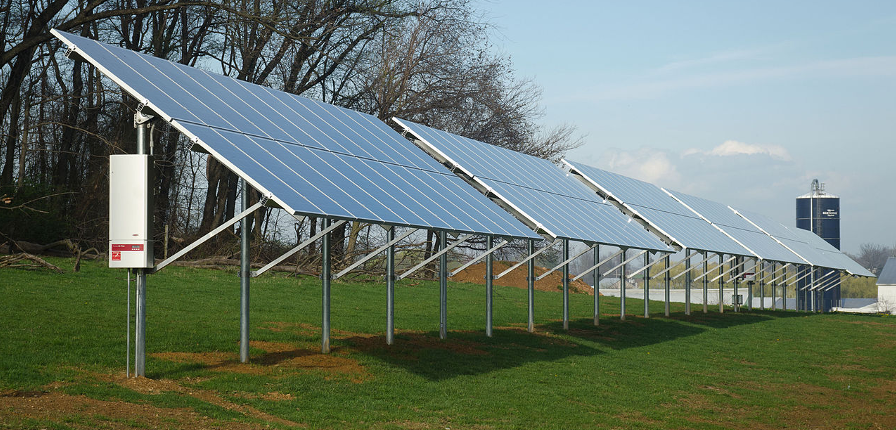
solar panels can be installed high enough to permit sheep grazing
Source: Wikipedia, Solar Power in Pennsylvania
The county began changing the local zoning ordinance to drop solar facilities as an automatically permitted, "by-right" use in areas zoned for agriculture. Solar farms would be treated as industrial facilities rather than as agricultural farms, and would be restricted to areas zoned for general business and industrial uses.
The Carilion New River Valley solar facility in Pulaski County did adopt "solar sheep" as the solution for mowing the grass around the panels. The developer of the project, Secure Futures, partnered with a local shepherd in a barter arrangement. The solar facility provided free pasture for his flock, and the sheep kept the grass so low that the panels would never be shaded.
The panels also protected the sheep from overheating. They rotated as the sun moved, so at noon each panel was horizontal in a "table top" position. That guaranteed shade for the sheep.
In Louisa County, Dominion Virginia Power built a 20MW solar farm on 250 acres. In 2016, Belcher Solar LLC proposed in 2016 to build a 1,000-acre solar farm generating 88MW. County ordinances already required the companies to obtain a conditional use permit for those industrial uses, on land zoned for agriculture.
Accomack County officials understood that adding solar panels to the 200-acre farm would increase property values. Normally, a county would benefit from extra taxes. However, in 2016 the General Assembly exempted solar systems generating 1MW or more from 80% of local property taxes.23
In addition to concerns about loss of farmland, opposition to solar-fired power plants has been generated when proposals involved clearing forested areas. Replacing trees with grass increases stormwater runoff and reduces biodiversity.
Neighbors have objected to what they consider to be an industrial use detracting from their views and reducing property values. In 2018, the Culpeper Board of Supervisors approved the county's first solar project. It was authorized on 1,000 acres of farmland. Neighbors sued, citing the historic character of the land and claiming there may be Civil War burials there. Cricket Solar ultimately withdrew its plans to install 380,000 solar panels, as opponents emphasized the impacts on property values:24
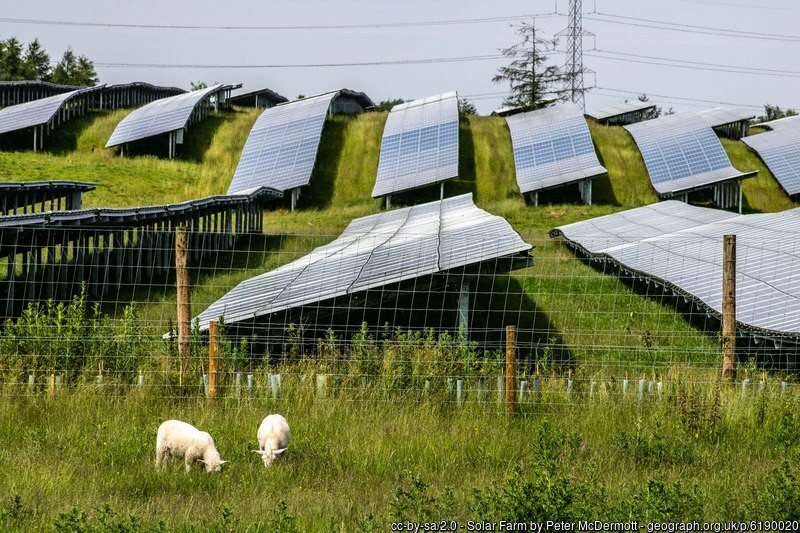
"agrivoltaics" involves co-locating farming activities with solar panels, maximizing use of farmland
Source: Geograph, Solar Farm (by Peter McDermott)
The economic driver for achieving the Renewable Portfolio Standard through voluntary action by investor-owned utilities may not be sufficient to meet the goals in the Virginia Energy Plan. The Attorney General concluded in 2012 that the cost of bonuses to electric utilities was excessive compared to the benefits to customers, and that the bonuses had failed to stimulate sufficient new construction of renewable power sources.25
The Department of Energy launched its 10-year SunShot Initiative in 2011. Research and development grants were designed to reduce the costs of electricity produced by photovoltaic panels to $0.06 per kilowatt-hour, and to reduce the costs of utility-scale solar systems to $1 per watt (not including incentives):26
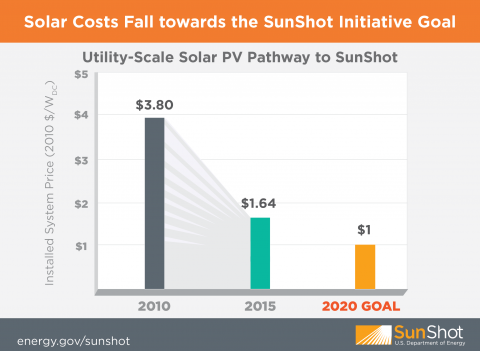
the Department of Energy goal is to cut costs of utility-scale solar systems by 75% within a decade
Source: Department of Energy, About the Sunshot Initiative
Widespread implementation of solar power in Virginia would affect the economics and politics of the electricity utilities. Since the 1880's, electricity has been generated at central power plants and distributed through a network of wires to customers. There are economies of scale in electrical generation and distribution, and in Virginia two utilities (Dominion and American Electric Power) have service area monopolies that provide electricity to most of the state.
If power generation was highly decentralized, with solar panels on rooftops of individual homes generating enough power to meet most household demands, then the revenue flowing to those utilities would be diminished. The two dominant utilities might see their extraordinary influence in the General Assembly decline, along with their economic influence.
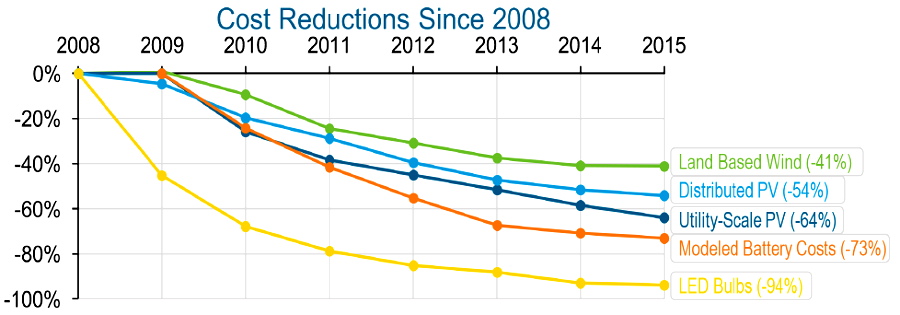
as costs drop, decentralized generation through photovoltaic panels on rooftops could threaten the traditional structure of the utility industry
Source: Department of Energy, 6 Charts that Will Make You Optimistic About America's Clean Energy Future
In addition, operation of the transmission grid would be affected if generation was decentralized. A smart grid could use automated switching and other techniques to balance decentralized generation with already-decentralized demand by customers, so the technical challenges are less difficult to address. The economics and politics are more daunting. Private, cooperative, and municipal utilities are reluctant to invest in grid infrastructure upgrades that will reduce their sales of electricity, while elected officials are reluctant to raise taxes to provide public funding to upgrade the privately-owned electrical distribution grid.
Utilities fear that a large percentage of customers will install solar cells and reduce their purchases of electricity, while distribution of electricity generated at decentralized locations will become more complex. Reliability standards require utilities to keep expensive generation capacity available, such as a power plant fueled by natural gas. If the PJM regional transmission organization does not call for generation from that facility, then the utility would receive no revenue to offset its costs.
In that scenario, overhead costs for managing utilities will increase. Someone must pay the costs for more unused reserved and for more complex "smart grid" distribution.
Odds are, a greater percentage of overhead costs will be allocated to the standard service charge that every customers pays for a link to the grid and a reliable assurance of electricity 24/7, even when no electricity is purchased.
In 2014, Appalachian Power (APCo) requested approval from the State Corporation Commission to start increasing the "customer charge" for the fixed costs of providing electric service, from $8.35/month to match the actual cost of maintaining the generation and distribution infrastructure to provide service to residential customers. The utility claimed:27
The utility also proposed to impose "standby charges" on customers who installed solar panels or wind turbines that could generate between 10-20 kilowatts of electricity. Such a fee could help the utility fund the power lines and power plants that would be needed at times when renewable resources are not adequate to meet demand. Of course, higher fees charged to just those customers using solar/wind generation systems could deter a shift to decentralized renewable power sources.28
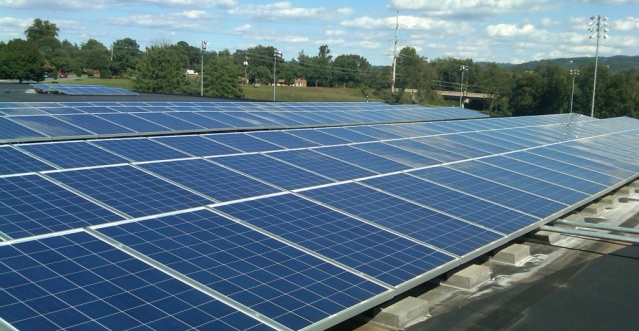
rooftop photovoltaic panels, such as these on Charlottesville High School, replace electricity from central power plants with locally-generated supplies
Source: City of Charlottesville, CitySolar
In 2014, the Energy Information Administration (EIA) reported that building new electrical generating capacity with solar-based systems was becoming competitive with building new coal-fired power plants, when calculating the costs of building and operating a generating plant for the predicted life of that facility over the next 30 years. Changing technology for solar had altered the traditional economic rationale for building centralized power plants and distributing electricity via wire to customers over great distances, in part because the EIA predicted new power plants emitting greenhouse gases would pay the equivalent of an emissions fee of $15 per metric ton of carbon dioxide.29
The trade association for investor-owned (for profit) electric companies, the Edison Electric Institute, has identified the spread of "distributed energy resources" as a long-term threat to the profitability of utility companies generating electricity. States that subsidize solar systems, mandate Renewable Portfolio Standards, and authorize net metering may spur enough new generation by homeowners and small power producers to reduce the dominance of the large utilities.30
Virginia has only "recommended" Renewable Portfolio Standards, for just investor-owned utilities. The Town of Front Royal operates a publicly-owned utility, but it has chosen to create a solar farm near the wastewater treatment plant to generate 2.5-megawatts of electricity. The town purchases its power through American Municipal Power (AMP), a non-profit that owns generation facilities and sells electricity to its members. Most of AMP's power plants, including coal-fired and natural gas-fired facilities as well as hydroelectric plants, are located in the Ohio River valley. One advantage of hosting a solar facility locally in Front Royal is that the town's costs for transmission will be minimized.31
"Dispatch" is still an issue for solar energy. Like electricity from wind turbines, solar-generated electricity is not available on a reliable as-needed basis. Baseload power plants fueled by coal and nuclear sources are reliable sources of electricity 24 hours a day, but inflexible and hard to stop/start in order to adjust to demand that varies throughout the day. Independent System Operators, which schedule generation and distribution of electricity through the grid, will be challenged to create a more-flexible, smarter system that can adjust quickly to shifting supply from solar/wind sources.
The difficulty in scheduling and dispatching solar will be overcome in part by the construction of more quick-to-start, quick-to-stop natural gas facilities, while the lower price of solar will result in utilities increasing the percentage of solar in their energy mix. As one executive for a utility buying electricity from different generation sources noted:32
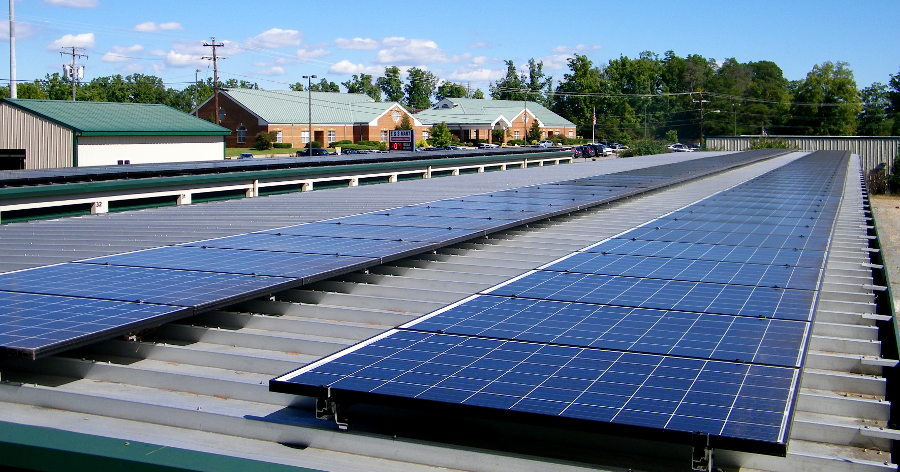
a USDA Rural Development grant helped fund installation of rooftop photovoltaic panels on the E&S Mart in AltaVista
Source: US Department of Agriculture (USDA), Reducing Energy Use and Costs & Getting #USDAResults for Virginia Businesses and Farmers
Renewables may not be too expensive in some area, but in Virginia the costs of electricity are relatively low. The state finally made a substantial commitment to incentivize solar power generation in December, 2015. Governor McAuliffe set a goal of purchasing 110 megawatts, 8% of the state's electricity, from solar companies.
Dominion Virginia Power committed to supply 75% of that total. The state will cover any cost above normal rates, making it the responsibility of Virginia's taxpayers to provide any necessary subsidy if the cost of renewable energy is above average.33
Even if the levelized cost of electricity becomes equal for facilities using solar vs. coal/natural gas/nuclear fuels, there will still be still major barriers in the regulatory environment and in the capacity of the power distribution grid to store and transmit electricity from solar-based facilities.
When electricity (or hot water) generated by solar systems is used directly at a home or factory, the slow emergence of a smart grid for transmission from intermittent power generations sources is not a concern. Baseload plants fueled by coal, nuclear, natural gas, or other sources can still provide electricity to such a home/business when the solar system is not generating (such as during the night) and when electricity stored in batteries has been exhausted.
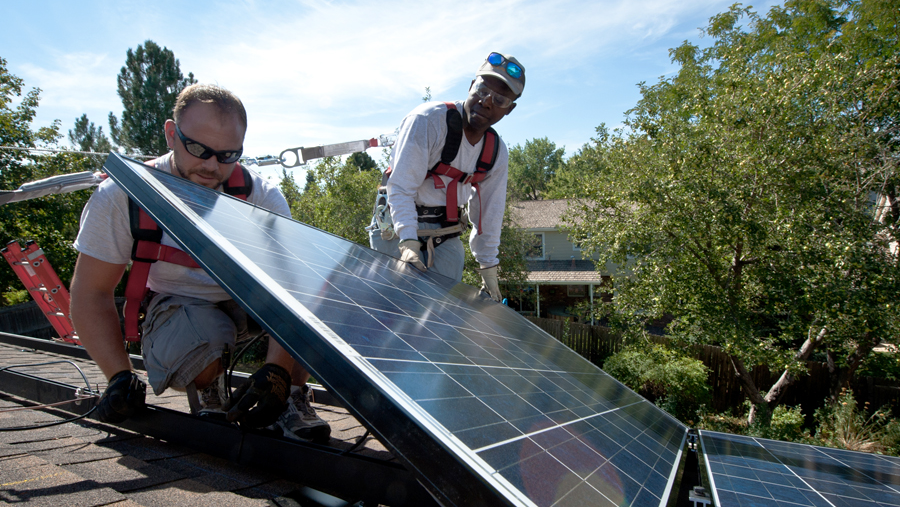
solar panels can be manufactured overseas, but installation will always create local jobs
Source: US Department of Energy, Quiz: Test Your Solar IQ
Utilities that have built integrated electricity generation and distribution networks in the last century, plus standby capacity to provide electricity on demand, anticipate their investments will be recovered over the long term by customers paying for electricity. In Virginia, the State Corporation Commission sets rates for electricity that guarantee private utilities will be profitable and able to repay debt incurred in building electrical infrastructure authorized by that state agency.
Local solar systems could alter demand for electricity using that infrastructure. If only a tiny percentage of customers choose to place solar panels at their home/business, then the reduction in demand and the economic impact would be minimal. However, if enough customers installed solar systems and purchases of electricity were substantially reduced, then the investments by those utilities in generation capacity and distribution systems would be "stranded" and the value of stock in those private utility companies would decline.
The power system operators have to change how electricity generation is scheduled from power plants, to accommodate the availability of solar power only during daylight hours. In 2013 the "duck curve" was recognized. Solar generation could meet a high percentage of demand until the late afternoon, at which point demand increased faster than gas/coal power plants could be switched on. Maintaining those generation facilities during the daytime in order to utilize them in the late afternoon created a surplus of electricity in the middle of the day, depressing the value of solar.34
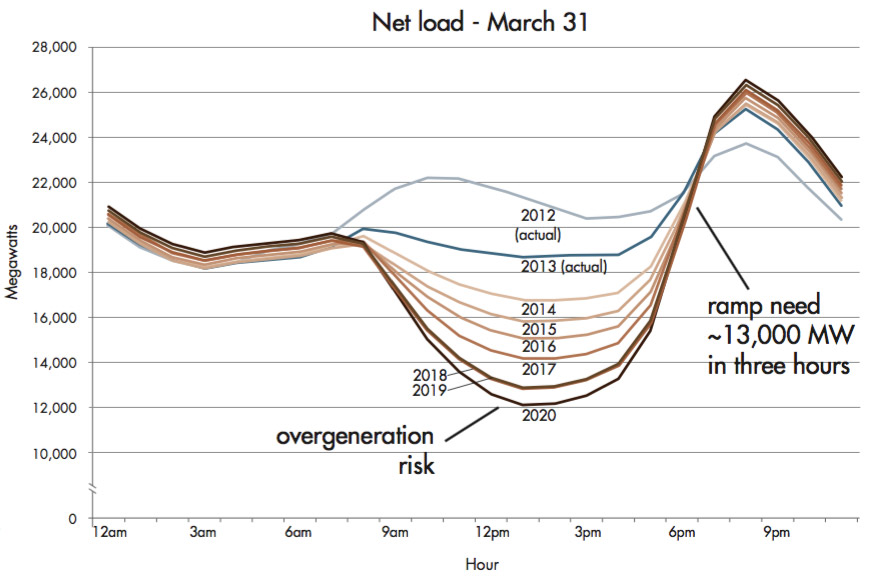
power system operators must manage the duck curve, when solar power can not ramp up quickly to meet afternoon peak demand
Source: National Renewable Energy Laboratory (NREL), Ten Years of Analyzing the Duck Chart
Federal Renewable Energy Tax Credits are scheduled to disappear after 2021. The schedule is:35
Ratepayers relying upon a private utility such as Dominion and APCo will be affected by the political and regulatory decisions made by the General Assembly and the State Corporation Commission, especially standby fees for connecting to the grid. Most houses with solar panels remain connected to the electrical grid, in order to ensure electricity will be available 24 hours/day. Only customers not connected to the grid will be able to use solar power without compensating the utilities that have provided a fall-back source of energy.
The intermittent availability of solar, even with batteries, will make it just a part of a diverse portfolio for a utility selling electricity to thousands of customers.
Solar can be a 100% solution in isolated sites, where solar panels may be the only energy source. Some homes and businesses are also completely off-the-grid. The Virginia Department of Transportation has installed highway signs and cameras in locations where it is too expensive to build a new distribution line to supply electricity.
The Living Energy Farm in Louisa County is an environmental education center and community cooperative that raises seeds for sale. It relies upon biofuels, solar hot water collectors, solar photovoltaic panels to generate electricity, and even uses a solar parabolic device known as the "death ray" to cook food. Other cooperative communities have reduced their reliance upon the grid down to 10-40% of average energy use, while the Living Energy Farm has cut is ties to the grid completely.36
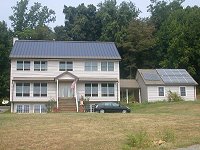
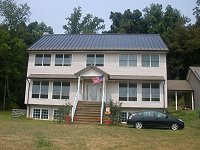
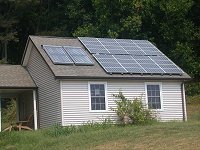
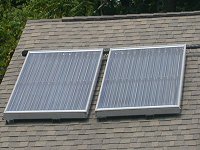
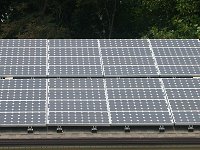
the 6kW capacity at the Hathaway solar home in Loudoun County generates all of the electricity required by that household
(click on thumbnails for full-size image)
Stormwater runoff violations were common during construction, when all vegetation was cleared. Compaction of the soil by heavy equipment during installation of solar panels made it difficult to revegetate a site afterwards. Agri-voltaics, with a crop of grass typically growing underneath the panels, was theoretically possible but rarely incorporated into utility-scale solar facilities in Virginia.
Installing a large number of solar panels converts land that once produced crops, forage, or trees into an electricity-generating operation, traditionally considered to be an industrial use. Nationwide, the US Department of Energy estimated 5 million acres of land would end up covered with solar panels.
In Virginia, most utility-scale solar facilities were built on former cropland that had been the least productive. The director of the Department of Environmental Quality estimated in 2023 that between 317,000–687,000 acres of land would be covered with solar panels by 2045, generating 30–65 gigawatts of electricity. He commented:37
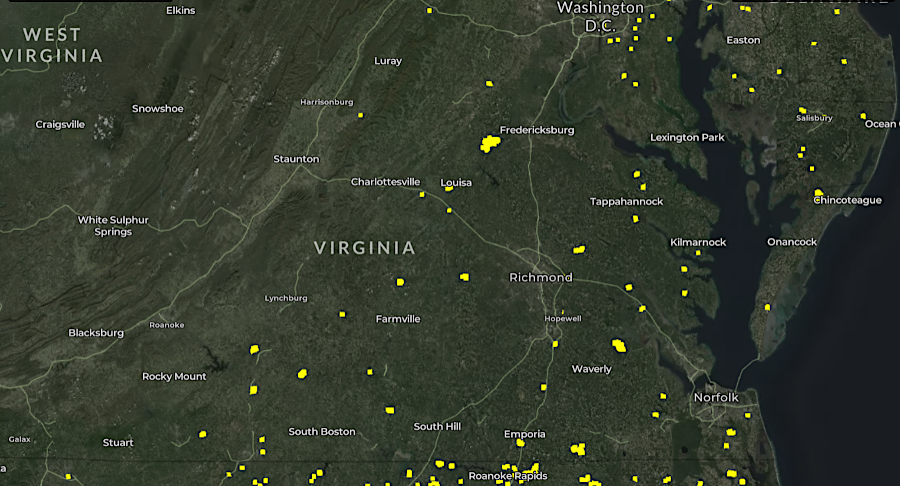
ground-mounted photovoltaic facilities generating 1MW or more and operational by the end of 2022
Source: US Geological Survey, US Solar Photovoltaic Database
One farmer made clear that he considered solar-fired power plants to still qualify as an agricultural use:38
The Clean Virginia Energy Plan passed by the General Assembly in 2020 called for all utilities to close down fossil-fueled power plants by the end of 2045. In its 2020 Integrated Resource Plan, Dominion Energy proposed to create 31.4-40.6GW (gigawatts) from new solar facilities.
Assuming industrial-scale solar power plants require 10 acres of solar panels to generate 1MW (megawatt) of electricity, replacing fossil-fueled power plants would require installing solar panels on 320,000-406,000 acres of land. A portion of the installation sites could include already-developed land, such as rooftops and parking lots where solar panels on poles could also provide shade.39
Source: Interstate Commission on the Potomac River Basin, Water Resources Impacts of Data Centers and Solar Fields and Tools to Mitigate Impacts - Webinar
New solar facilities require transmission capacity. Solar developers need interconnection agreements with local utilities distribution lines energized to 69,000 KV (kilovolts) or less, or to high-voltage lines carrying 69,000-750,000 KV. Transmission lines have limited capacity, so solar developers prioritize sites that will enable them to transmit and sell electricity to distant customers.
Utilities and energy merchants are building large-scale solar facilities to generate megawatts of electricity. Consumers are also installing solar on individual houses "behind the meter," and even batteries to supply home-produced electricity at night. That is causing utilities to plan for the loss of revenue, since customers will purchase less electricity.
Customers are remaining connected to the utilities, and they are still required to supply electricity when needed. For the utilities, revenues could drop but the fixed costs for transmission, emergency repairs, billing, and management will not be reduced. The response has been to increased the monthly minimum bill for customers for services other than the consumption of electricity.
In 2020, the Shenandoah Valley Electric Cooperative almost doubled its fixed rate. In 2021, it proposed another 20% increase in fixed charges and to add a new "demand" charge of 10 cents per kilowatt used. The demand fee was intended to offset the costs of ensuring adequate supply at all times. Generators had to be kept spinning in case demand increased, even when customers were using electricity from the solar panels on their house rather than drawing from the grid at the moment.
The increases were designed to ensure adequate revenue despite increased use of consumer solar within its distribution area. Solar United Neighbors fought the increase during the rate case at the State Corporation Commission. The solar advocates argued that the proposed increases were excessively high, that the minimum monthly fees would deter installation of new consumer solar capacity, and that economically-disadvantaged customers would be affected unfairly. Co-op managers were accused of prioritizing the sale of electricity, rather than facilitating how member-owners could reduce overall electricity use.
Shenandoah Valley Electric Cooperative managers responded that 2019 legislation by the General Assembly (HB 2547) encouraged a shift away from billing based on electricity use, and towards rates that accounted more accurately for the costs to meet demand on a 24/7 basis. The proposed rate change would not increase overall revenue for the co-op, but would more-accurately reflect the fixed costs to supply electricity to each customer:40
By 2022, solar panels generated electricity at a cost of $33/MWh compared to $43/MWh for natural gas facilities. Each 1,000 megawatts of new solar capacity reduced costs for natural gas purchases by $20 million/year.

solar facilities with 1MW capacity in 2023
Source: US Geological Survey (USGS), The U.S. Large-Scale Solar Photovoltaic Database
In 2022, ratepayers saved $50 million - funding that would have been transferred out of state to natural gas providers. The savings from solar-generated electricity in Virginia exceeded the net value of the state's tobacco crop.41
By the start of 2024, there were 5,418MW of solar capacity installed in Virginia, generating enough electricity to meet 6% of demand within the state. Another 8,314 MW were planned. Nationwide, there were enough solar panels in place to generate 200 GW.42

Dominion Energy has transmission capacity on the Northern Neck, but excess capacity varies significantly in different areas
Source: Dominion Energy, Hosting Capacity Tool
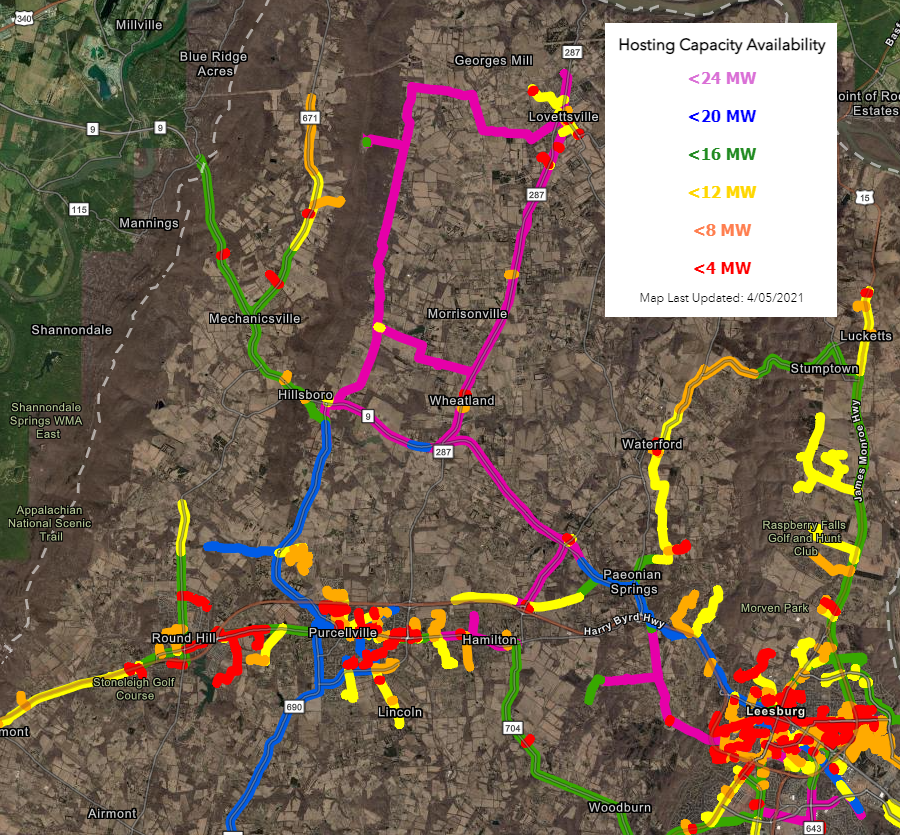
if solar generating facilities were built in western Loudoun County in 2021, there was transmission capacity to move electricity to data centers near Ashburn
Source: Dominion Energy, Hosting Capacity Tool
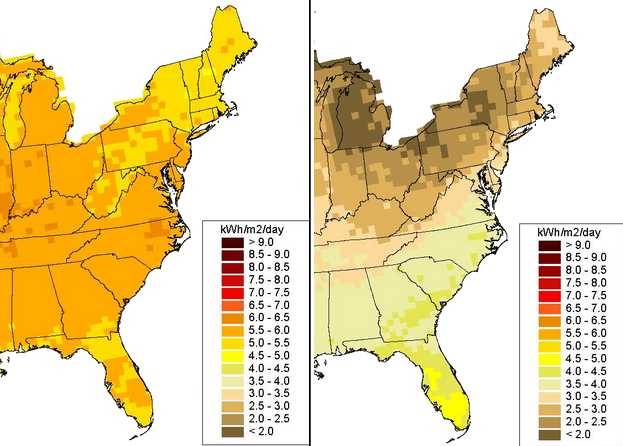
Virginia's solar power potential is seasonal - significantly higher in June (left) vs. December (right)
Source: National Renewable Energy Laboratory, U.S. Solar Resource Maps PV Solar Radiation (40km) Static Maps (1985 to 1991 data)
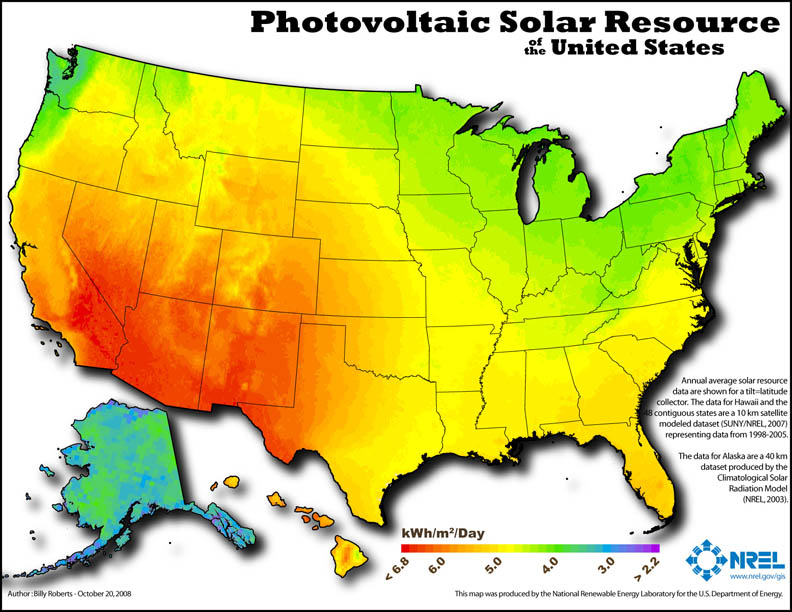
Virginia's solar power potential: 5kW per square meter, per day
Source: National Renewable Energy Laboratory, U.S. Solar Resource Maps (Data - 1998 to 2005 Low Resolution)
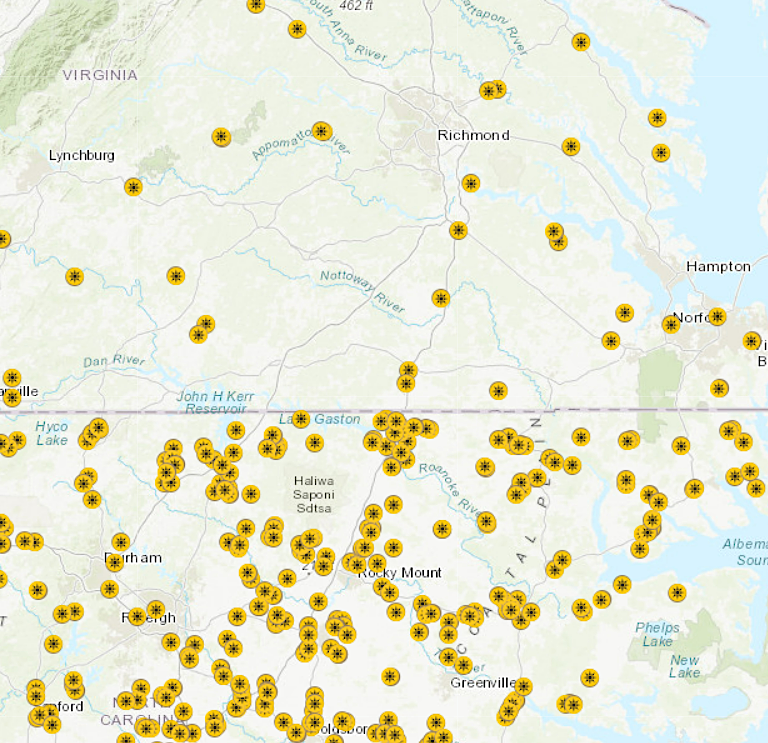
in 2022, there was a clear contrast between the number of solar facilities in North Carolina vs. Virginia
Source: Energy Information Administration, U.S. Energy Mapping System
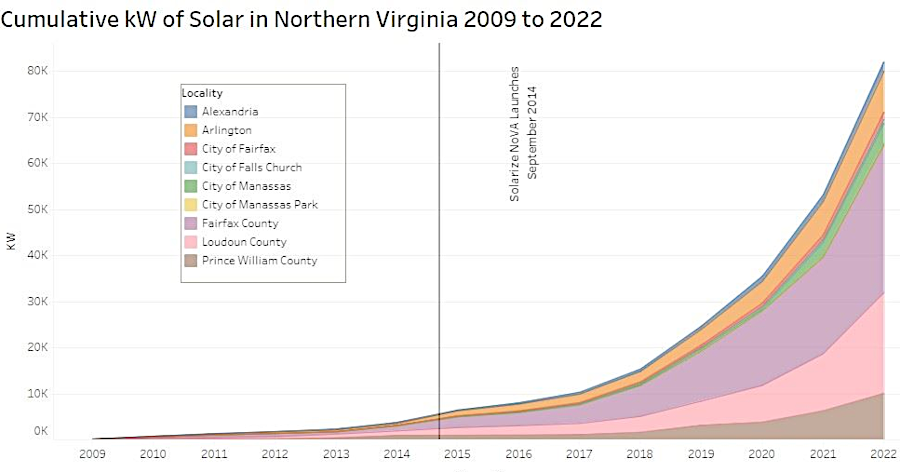
the growth of solar panels started to climb significantly in 2025
Source: Northern Virginia Regional Commission (NVRC), Solar Data for Northern Virginia